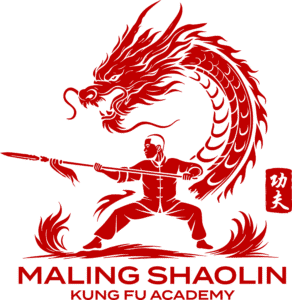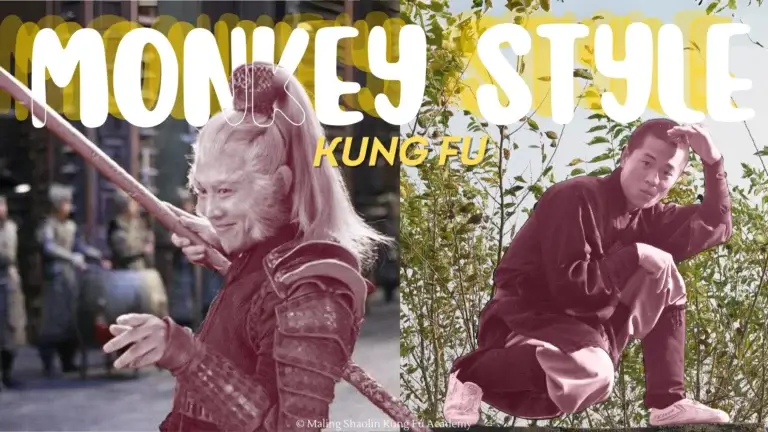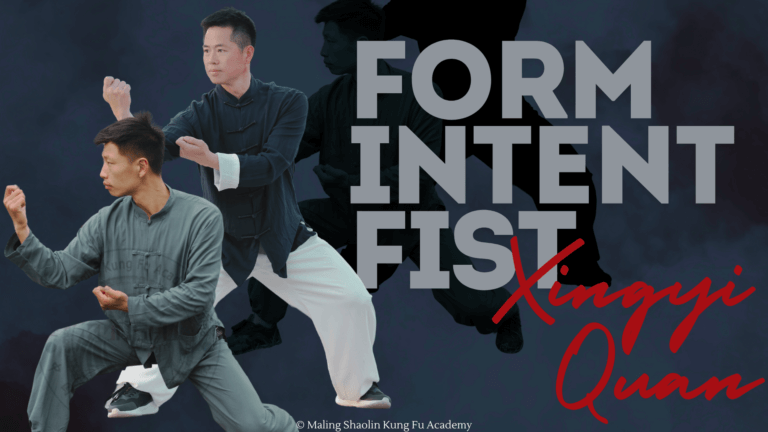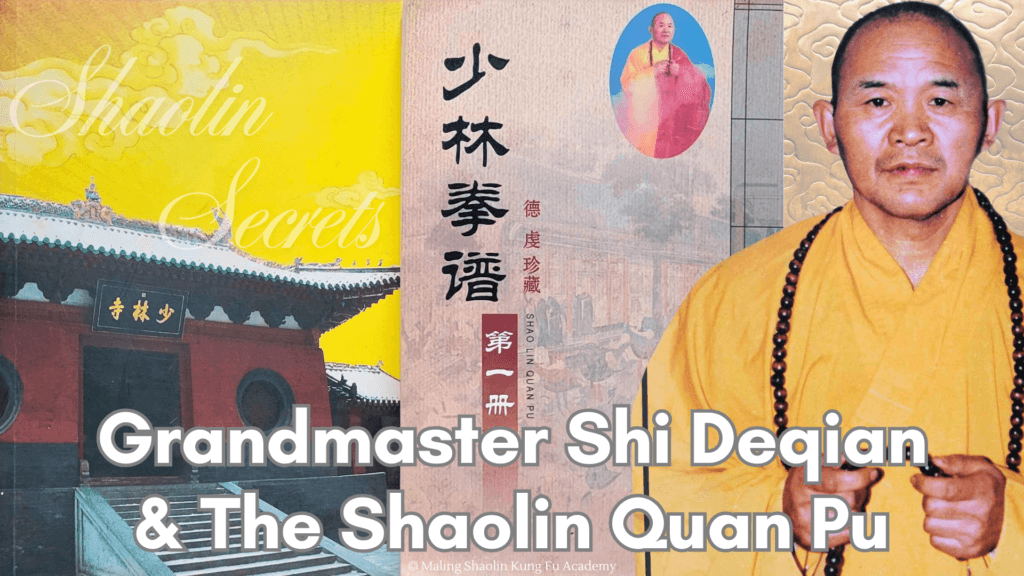
The world of Shaolin martial arts is vast and storied, filled with centuries of tradition, discipline, and philosophy. Among the most significant figures in preserving this rich history is Grandmaster Shi De Qian, a 31st-generation Shaolin monk, historian, and martial artist. Revered as “The King of Shaolin Books,” Grandmaster Shi De Qian dedicated his life to recording and safeguarding the techniques and principles of Shaolin kung fu. His most monumental work, the Shaolin Encyclopedia, is a staggering four-volume compilation totaling nearly 4,000 pages, covering an extensive range of Shaolin forms, weapons, and teachings.
Yet another remarkable contribution from Grandmaster Shi De Qian is his Shaolin Quan Pu (少林拳谱), or Shaolin Fist Form Manual. This eight-volume, 48-chapter series goes beyond mere documentation of Shaolin hand forms. It encompasses a wealth of knowledge, including weapons techniques, qigong practices, injury remedies, Dim Mak (pressure-point striking), traditional medicine, and even historical records of Shaolin warrior monks. The handwritten manuscripts, accompanied by thousands of meticulously crafted hand-drawn illustrations, provide an invaluable resource for martial artists, historians, and scholars alike.
What is Shaolin Quan Pu?
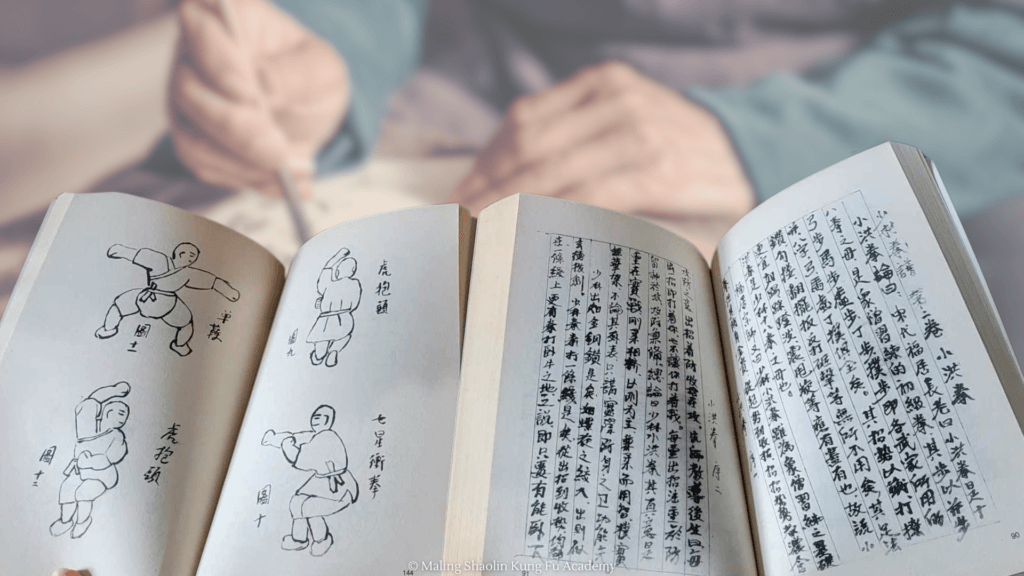
The Shaolin Quan Pu series is one of the most exhaustive manuals on Shaolin martial arts, capturing the essence of Shaolin hand and weapon forms, combat strategy, internal cultivation, and even unique or lesser-known martial disciplines. Book 1 alone contains foundational Shaolin principles and key hand forms such as Xiao Hong Quan, Da Hong Quan, and Luo Han Quan. These early chapters lay the groundwork for the deeper and more intricate teachings found in later volumes.
A fascinating aspect of Shaolin Quan Pu is its diverse range of weapons, including some unconventional and almost comical choices. Alongside traditional weapons like the staff, broadsword, straight sword, and spear, the manual also features shoes, brooms, rice bowls, wicker baskets, calligraphy brushes, and even dead fish with hidden daggers inside. These unusual weapons reflect the adaptability of Shaolin monks, who often had to defend themselves with whatever was at hand during unexpected attacks.
Chapters Overview of Shaolin Quan Pu
Below is an outline of the first couple of books of Shaolin Quan Pu, showcasing its breadth and depth:
Book 1
- Martial Arts Virtue & Introduction (Wude Yu Gai Shu)
- Secrets of Shaolin Fist (Shaolin Quan Shu Mi Ji)
- Shaolin Little Hong Quan (Shaolin Xiao Hong Quan)
- Shaolin Big Hong Quan (Shaolin Da Hong Quan)
- Shaolin Luo Han Quan (Shaolin Luo Han Quan)
- Shaolin Luo Han 18 Hands / Tongbi Fist (Shaolin Luo Han Shi Ba Shou | Tong Bi Quan)
- Shaolin Plum Blossom Fist/Palm (Shaolin Mei Hua Quan/Shou)
Book 2
- Shaolin Seven Star Fist (Shaolin Qi Xing Quan)
- Shaolin Guardian Fist (Shaolin Kan Jia Quan)
- Shaolin King Kong Fist (Shaolin Jin Gang Quan)
- Shaolin Cannon Fist (Shaolin Pao Quan)
- Shaolin Long Guard Xinyi Fist (Shaolin Chang Hu Xin Yi Men Quan)
- Shaolin 5 Harmony Fist (Shaolin Wu He Quan)
- Shaolin 6 Harmony Fist (Shaolin Liu He Quan)
The full series extends across eight books, covering various hand forms, weaponry, combat applications, qigong, and historical records of Shaolin’s warrior monks.
Shaolin Quan Pu: A History Of Dedication
The Historical Importance of Shaolin Quan Pu
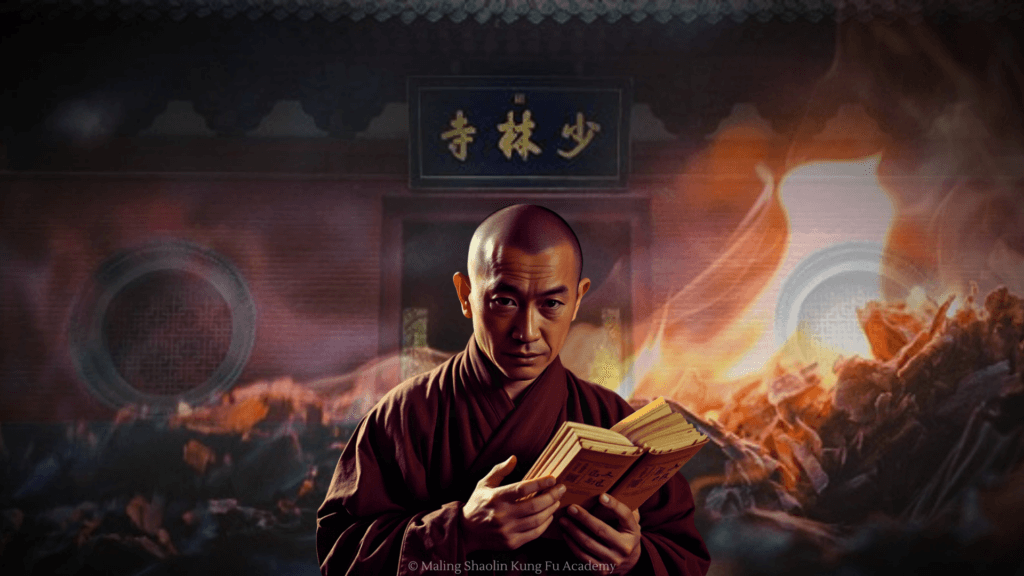
Nestled in the western part of Song Mountain, the Shaolin Temple has long been renowned for its martial arts traditions. Over the centuries, Shaolin monks have developed and preserved an extensive body of knowledge on both martial techniques and traditional Chinese medicine. Unfortunately, much of this historical documentation was lost in 1928 due to a devastating fire caused by warlord conflicts, reducing centuries of wisdom to ashes.
However, one of the few surviving texts, the Shaolin Quan Pu (少林拳谱, “Shaolin Fist Manual”), remains an invaluable resource today, thanks to the dedicated efforts of Monk Yong Xiang (释永祥). His perseverance ensured the preservation of this crucial text, safeguarding it for future generations.
The War and Political Turmoil of the 1920s
The late 1920s were a period of great instability in China, marked by warlord conflicts and internal strife. Following the fall of the Qing Dynasty in 1912, China was fractured into competing factions, with regional warlords vying for control. This era, often referred to as the Warlord Era (1916-1928), saw frequent battles, shifting alliances, and devastation across the country.
In 1926, the Northern Expedition, led by the National Revolutionary Army (NRA) under Chiang Kai-shek, aimed to unify China by eliminating warlord rule. The campaign brought intense military action to Henan Province, where the Shaolin Temple was located. Warlords and nationalist forces clashed, leading to widespread destruction. By 1928, the situation had deteriorated further when the warlord Shi Yousan (石友三), aligned with the NRA, set fire to the Shaolin Temple during a battle, destroying much of its historical archives, relics, and martial arts manuscripts.
As chaos engulfed the region, many monks fled the temple, taking with them whatever knowledge they could salvage. Monk Yong Xiang, recognizing the imminent danger, completed his transcription of Shaolin Quan Pu in early 1928 and, under the instruction of his master, left for Changchun, Jilin, where he would protect the manuscript in secrecy for decades. His actions ensured that Shaolin martial heritage survived despite the temple’s destruction.
The Efforts of Monk Yong Xiang
Born in 1913, Yong Xiang entered the monastic life at the Shaolin Temple at the young age of seven. By 1926, as political turmoil increased, he foresaw the need to preserve the martial knowledge of Shaolin. With the support of Abbot Zhen Xu (贞绪) and Master De Chan (德禅), he undertook the painstaking task of hand-copying the entirety of Shaolin Quan Pu.
In January 1928, after completing the transcription, Yong Xiang was instructed by his master to take the manuscript and leave the temple. He returned to his hometown of Changchun, Jilin, where he carefully hid the text for decades. It remained in secrecy for over 50 years, until China’s resurgence in the 1980s allowed him to safely return it to the Shaolin community. Before his passing, he entrusted the manuscript to Master De Qian (释德虔) for safekeeping.
The Role of Master Shi De Qian: “The King of Shaolin Books”
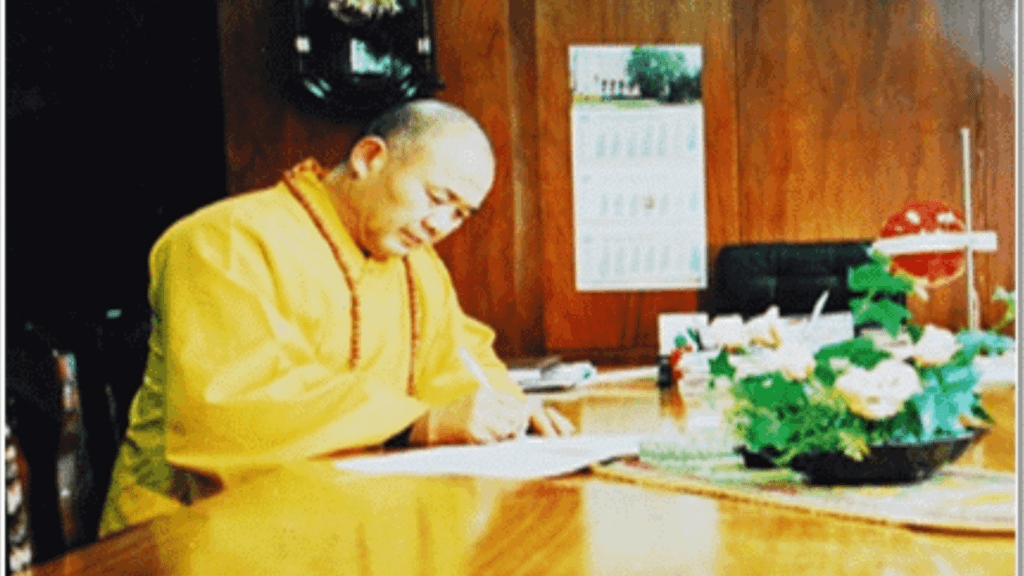
Master Shi De Qian (释德虔) played a pivotal role in preserving and expanding upon Shaolin Quan Pu. He dedicated over two decades to an extensive research journey across 17 Chinese provinces and various Southeast Asian countries, aiming to preserve and document the rich heritage of Shaolin martial arts. His meticulous efforts involved collecting rare manuscripts, conducting interviews with martial arts masters, and compiling detailed records of various styles and techniques. His efforts led to him being honored as “The King of Shaolin Books”, and his works reached over 80 countries and regions.
Tragically, in 2007, De Qian was diagnosed with cancer. In his final days, he entrusted his life’s work—including over 100 manuscripts and historical texts—to his wife, urging her to ensure their publication. This led to the release of a revised and expanded edition of Shaolin Quan Pu, preserving the original hand-copied manuscript alongside additional annotations.
Though he was known as a man of written word, he was also a dedicated sifu, Master to select disciples within the Shaolin Temple. To them, he passed on his will to continue spreading the skills, philosophies, and life lessons from generations of Shaolin monks to students from around the world. Thus, Master Shi Xing Jian (also known as Master Bao) opened up Maling Shaolin Kung Fu Academy, welcoming students from around the globe. Here he embraces traditional kung fu, honoring the lineage of his forebearers.
The Unique Value of Handwritten Manuals
Historically, martial arts were passed down through oral tradition, with very few written records. The hand-copied versions of Shaolin Quan Pu are extremely rare and valuable, as they represent direct knowledge from generations of Shaolin masters. Many traditional styles have been lost due to warfare, secrecy, or lack of documentation, making this manuscript one of the most important surviving works in Chinese martial arts history.
Unveiling the Introduction to Book 1
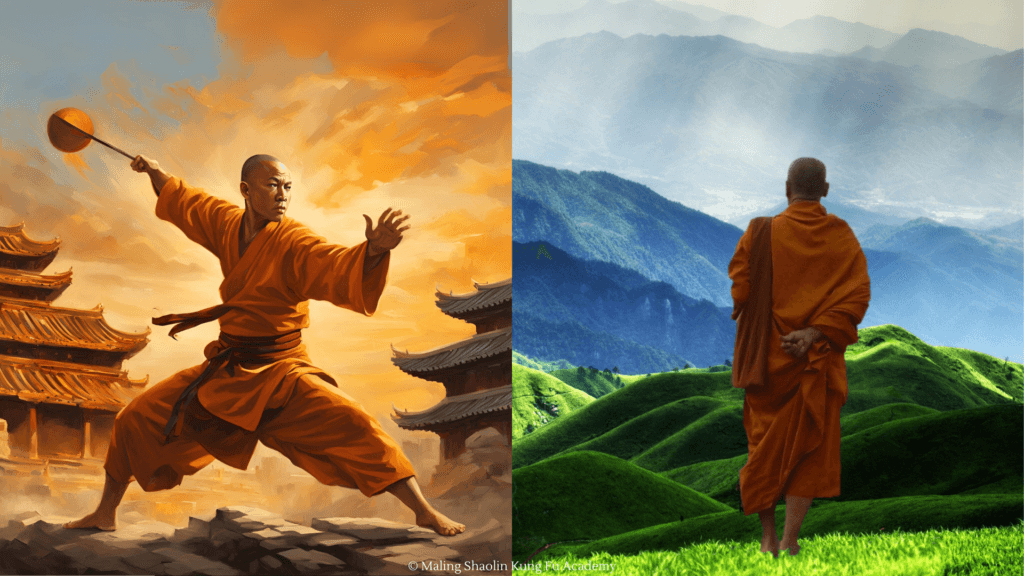
The introduction of Book 1 of Shaolin Quan Pu provides crucial insight into the philosophy, principles, and purpose behind the teachings of Shaolin martial arts. As detailed in the manuscript, Shaolin kung fu is not just about combat; it is a system rooted in Buddhist philosophy, discipline, and physical cultivation. This section emphasizes the significance of both physical mastery and internal cultivation, which have been integral to Shaolin kung fu for centuries.
The Core Tenets of Shaolin Martial Arts
- Martial Morality (武德, Wude) – Shaolin kung fu is not only about combat prowess but also about virtue, discipline, and ethical behavior. Wude is divided into two main aspects:
- Morality of Action (行为道德): Respect, humility, justice, and courage in practice.
- Morality of Mind (心性道德): Patience, perseverance, wisdom, and self-discipline in personal growth.
- Balance Between Internal & External Training (内外兼修, Nei Wai Jian Xiu) – Shaolin teachings emphasize the harmony between external strength (explosive power, speed, agility) and internal energy cultivation (breathing techniques, qigong, and meditation). The introduction details how proper training develops both the body (外功, Waigong) and mind (内功, Neigong), ensuring martial efficiency without neglecting inner peace.
- The Purpose of Combat – Unlike modern competitive fighting, Shaolin martial arts were historically designed for survival and self-defense. The introduction discusses the evolution of hand-to-hand combat, battlefield techniques, and the necessity of adaptability. These teachings were passed down through generations, often in secrecy, and compiled into structured manuals like Shaolin Quan Pu.
- Historical Transmission of Knowledge – The book’s introduction also highlights how Shaolin monks preserved their combat knowledge through oral tradition, handwritten manuals, and symbolic forms. Many of these texts were destroyed in various historical conflicts, making Shaolin Quan Pu one of the most valuable surviving records of authentic Shaolin martial arts.
Key Themes Explored in the Introduction
- Training Structure: The book outlines a progressive system of learning, ensuring students first master the foundational stances and movements before advancing to intricate techniques.
- Monastic Life & Discipline: A significant portion of the introduction delves into the monastic lifestyle, emphasizing daily routines, meditation, and moral conduct.
- The Connection Between Qigong & Martial Power: The introduction explains how qigong (气功) is the secret behind Shaolin’s legendary strength, allowing monks to perform seemingly impossible feats of endurance and power.
The opening chapters set the stage for the entire Quan Pu series, ensuring that readers and practitioners approach Shaolin kung fu with the proper mindset and respect for its deep-rooted traditions.
The Lasting Legacy of Grandmaster Shi De Qian
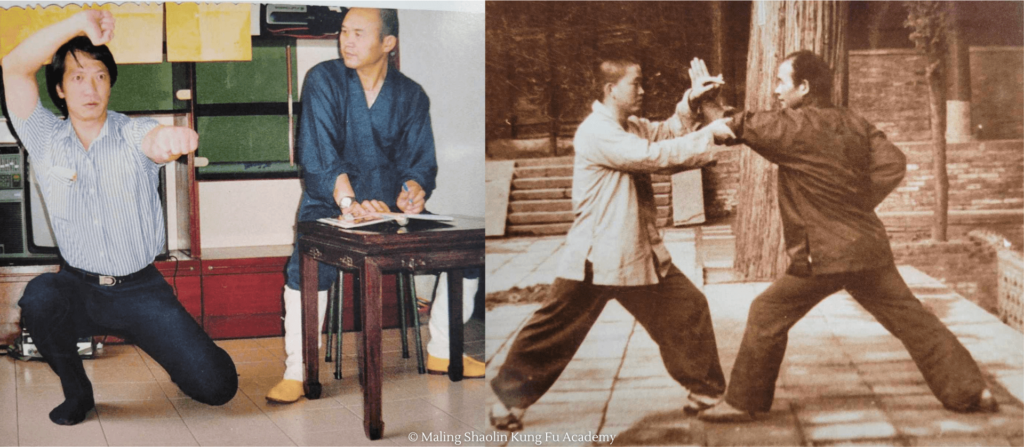
Grandmaster Shi De Qian was more than just a martial artist—he was a historian and guardian of Shaolin’s rich heritage. His dedication to preserving and compiling these teachings has ensured that traditional Shaolin kung fu remains accessible for generations to come. His works have inspired countless martial artists worldwide, many of whom continue to study and implement his teachings today.
For those interested in exploring his works further, some publications, such as Shaolin Muscle-Tendon Change Classic (Yi Jin Jing), are available in various formats, including instructional DVDs.
Additionally, video demonstrations of some of the techniques recorded by Grandmaster Shi De Qian can be found online, offering a glimpse into the deep and refined movements of Shaolin kung fu:
Through the Shaolin Quan Pu, Grandmaster Shi De Qian, Monk Yong Xiang, and those that came before, have left behind an unparalleled treasure trove of Shaolin wisdom, ensuring that the art, philosophy, and combat techniques of Shaolin kung fu continue to thrive in the modern era. Their legacies live on in the hands of dedicated practitioners, scholars, and anyone who seeks to understand the true essence of Shaolin.
A Valuable Resource and Collector’s Item
While the Shaolin Quan Pu series has never been translated into English due to the extensive time, resources, and personnel the process would require, Chinese editions of the series are available within China. For those interested in acquiring a copy, Shaolin Quan Pu can be purchased through the Maling Shaolin Kung Fu Academy, which can assist in shipping them internationally.
Even if you cannot read traditional Chinese, this series is a valuable collector’s item and reference piece. The books are filled with thousands of hand-drawn illustrations, making the series an invaluable visual resource for martial artists, scholars, collectors, and even novelists. Its historical significance, paired with its rich visual content, ensures that it remains a meaningful and prestigious addition to any collection.
If you are interested in one subject in particular, the books can be purchased individually as well. To see the full list of book and chapter titles, visit this Reddit post.
For more information or to discuss purchasing and international shipping, feel free to reach out to Maling Shaolin Kung Fu Academy.
Final Thoughts
The survival of Shaolin Quan Pu is a testament to the resilience and dedication of the Shaolin monks who fought to preserve their heritage against all odds. Thanks to Monk Yong Xiang and Master De Qian, practitioners today have access to one of the most comprehensive and historically significant martial arts texts ever recorded.
As we begin exploring this series, we uncover not only technical martial knowledge but also the philosophical and spiritual depth that makes Shaolin kung fu truly unique. This book is more than just a record of techniques—it is a living history of Shaolin.
If you are passionate about traditional martial arts, Shaolin history, or wish to deepen your knowledge of authentic kung fu, the Shaolin Quan Pu series is an essential read. Over the coming months, we will strive to share insights from each book, diving deeper into the techniques, history, and philosophies embedded within these texts.
📖 Have you encountered Grandmaster Shi De Qian’s works before? What are your thoughts on the preservation of Shaolin martial arts through written records? Let us know in the comments below! 👇
